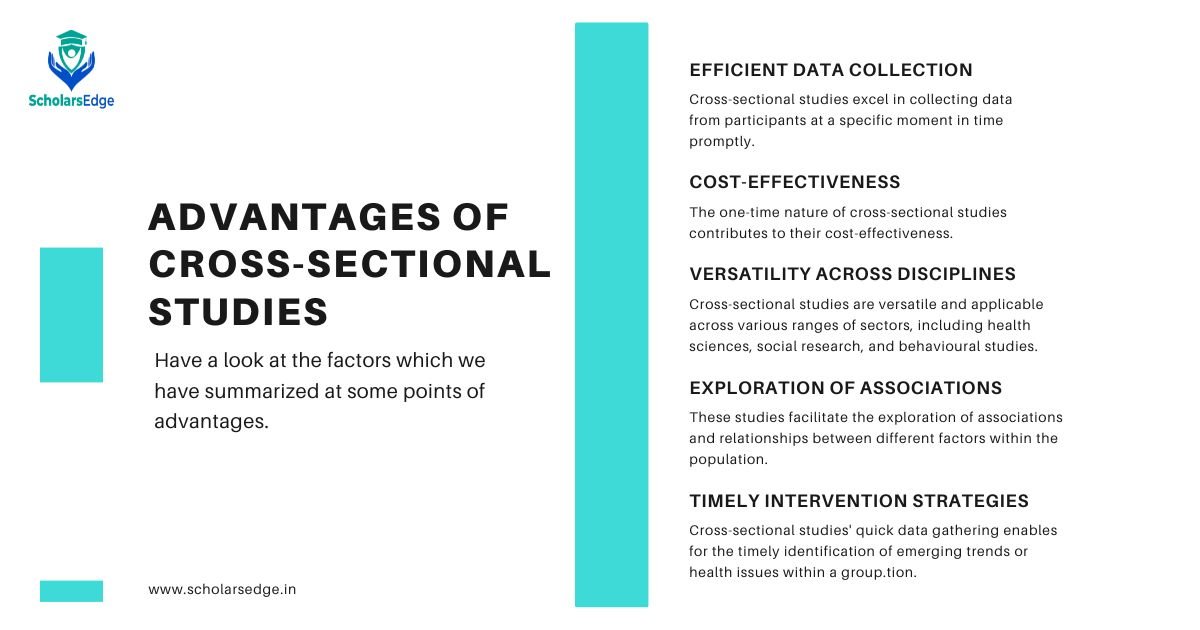
Introduction to the Cross-Sectional Study Method
As the definition goes, the cross-sectional study method is a methodology used by researchers, where they look at data that is collected from a large group of people at a particular moment in time, which can define certain characteristics individually. In this blog, we’ll dive deeper into what this method involves and provide you with all the necessary details. It is effective for researchers seeking rapid data collection, cost-effectiveness, and a deep understanding of population health.
This method is commonly used by researchers in various fields to assess the distribution of traits, behaviours, or conditions within a population at a particular moment. So fasten your seatbelt as we take you on the journey through its key characteristics, advantages, and several other factors, shedding light on its role in shaping our understanding of diverse fields, from health sciences to social research.
Importance of Cross-Sectional Study Method in Research
The cross-sectional study method is one of the most common methods used by researchers to gather information within the boundaries of the population. No doubt, it provides general information about the public, by studying them individually at a particular moment. But it is not always applicable, as with time changes occur in society. However, apart from this single factor, this study method can help us find information with great details. This is a cost-effective and efficient way to produce better results when compared to others.
Key Characteristics of Cross-Sectional Study Method
The key characteristics of a cross-sectional study method distinguish them as a snapshot method capturing a population’s attributes at a specific point in time. The first factor is that the design involves a simultaneous collection of data from individuals within a defined population, offering a wide range of overviews. This method is very effective for finding prevalence, allowing researchers to understand the distribution of various factors in the chosen population.
Note that Cross-Sectional Studies do not follow participants over time but instead focus on a single cross-section. To obtain this, they employ surveys, interviews, or make general observations. This characteristic makes them versatile, providing rapid insights and also contributing significantly to evidence-based research.
Definition and Scope of Cross-Sectional Studies
In simplest terms, Cross-Sectional Study Methods are a type of study done over a population, where data is collected from the people at a single point in time. Unlike other methods of research such as longitudinal studies, cross-sectional studies provide any data at the instant and are not observed for a whole period. These studies are made to examine the prevalence of certain conditions, behaviours, or factors within the chosen boundary of people.
As mentioned above, different types of surveys, interviews, or observations are done to analyse relationships and patterns across diverse variables. The design is simple yet effective, making cross-sectional studies valuable in assessing public health issues, identifying risk factors, and informing policy decisions. Mentioned below are some applications which you might want to know:
Prevalence assessment
The cross-sectional study method involves determining the proportion of a specific condition within a population at a given time. This method provides information on the frequency and distribution of health-related factors, which helps in understanding the current burden of diseases and informing public health strategies.
Risk factor identification
In Cross-Sectional Study Method, risk factor identification involves pinpointing factors associated with a specific condition or disease at a single point in time. This efficient approach enables researchers to swiftly identify and analyse potential contributors to health issues, informing preventive strategies and interventions based on prevalent risk factors within the population.
Health policy informatics
Health policy informatics, within cross-sectional study methods, involves utilising data to shape healthcare policies. These studies offer insights into disease prevalence, healthcare utilisation, and intervention effectiveness, aiding policymakers in evidence-based decision-making. This strategic approach ensures that health policies align with the current health status and needs of the population.
Behavioural Research
In the domain of behavioural research, cross-sectional studies serve as vital tools to investigate attitudes, behaviours, and perceptions within populations. Conducted at a single point in time, these studies offer swift insights into societal trends, aiding in the understanding of diverse behavioural patterns and contributing to evidence-based decision-making in social sciences.
Study Design and Methodology
Study Design and Methodology in cross-sectional study methods are crucial components governing the precision and reliability of gathered insights. The design entails simultaneous data collection from participants within a defined population at a specific moment. Methodologically, surveys, interviews, or observations are employed to capture a wide array of variables efficiently.
Random or stratified sampling techniques ensure representativeness. The emphasis on a singular time point distinguishes this design. Careful consideration of ethical standards and minimising bias enhance the method’s validity. Well-defined protocols in data collection and statistical analysis contribute to robust findings, making the study design and methodology pivotal in ensuring the study’s overall integrity.
Designing a Cross-Sectional Study
This involves meticulous planning to yield meaningful results. Begin by clearly defining the research question and objectives. Identify the target population and choose an appropriate sampling method, ensuring representativeness. Develop a comprehensive survey or interview instrument, addressing key variables of interest.
Consider ethical considerations and obtain necessary approvals. Implement robust data collection protocols, emphasising reliability and validity. Analyse data using appropriate statistical methods, recognizing potential confounders. Interpret findings with an awareness of the study’s limitations. This thoughtful approach in designing a Cross-Sectional Study ensures its effectiveness in capturing a snapshot of population characteristics for insightful research outcomes.
Methodological considerations
Methodological considerations in the Cross-Sectional Study Method are paramount for robust research outcomes. Rigorous survey instruments, precisely formulated interview scripts, or meticulous observation protocols are vital. Sampling techniques, whether random or stratified, warrant careful selection to ensure a representative population.
Addressing potential biases, like selection bias or recall bias, strengthens the study’s validity. Clear documentation of data collection procedures and standardised analysis methods enhances replicability. Methodological rigour ensures the reliability of insights derived from cross-sectional studies, reinforcing their significance in informing evidence-based conclusions across health sciences, social research, and behavioural studies.
Advantages of Cross-Sectional Studies

The advantages of Cross-Sectional Studies encompass several key aspects, making them a favoured research approach in various disciplines. Have a look at the factors below, which we have summarised at some points of advantages.
Efficient Data Collection
Cross-sectional studies excel in collecting data from participants at a specific moment in time promptly. This efficiency is especially useful when researchers want to get a glimpse of the current state of affairs within a community without the need for lengthy observation periods.
Cost-Effectiveness
The one-time nature of cross-sectional studies contributes to their cost-effectiveness. Unlike longitudinal studies that demand sustained data collection over an extended period, cross-sectional designs are often more economical, making them accessible to researchers with budget constraints.
Versatility Across Disciplines
Cross-sectional studies are versatile and applicable across various ranges of sectors, including health sciences, social research, and behavioural studies. Its ability to analyse a wide range of variables at a specific moment allows it to adapt to different research questions and contexts.
Exploration of Associations
These studies facilitate the exploration of associations and relationships between different factors within the population. Researchers can analyse correlations and patterns, offering valuable insights into the complex interplay of variables.
Timely Intervention Strategies
Cross-sectional studies’ quick data gathering enables for the timely identification of emerging trends or health issues within a group. This data is critical for developing successful intervention methods and implementing evidence-based practices.
Comparisons with Other Study Designs

Comparisons with other study designs illuminate the unique attributes of Cross-Sectional Studies, here are points we have mentioned below about some key differences. Have a read:
Cross-Sectional vs. Longitudinal Study Method
- Cross-sectional research methods take a picture at a single point in time, whereas longitudinal research follows people throughout time.
- Longitudinal studies shed light on temporal changes, whereas cross-sectional studies provide a static perspective.
- Cross-sectional studies are more suited to quick assessments, but longitudinal studies are better suited to identifying trends and causal linkages over time.
Cross-Sectional vs. Case-Control Studies
- Cross-sectional studies look at prevalent conditions at a single point in time, whereas case-control studies compare people who have and don’t have a specific ailment.
- Case-control studies focus on investigating causal linkages, whereas cross-sectional studies focus on prevalence and association.
Comparative analysis clarifies the strengths and limitations of each approach, guiding researchers in selecting the most fitting design based on their research objectives and temporal considerations.
Conclusion
The exploration of Cross-Sectional Studies unveils its major role in diverse research realms. The efficiency, cost-effectiveness, and ability to provide data on population make it very useful to the researchers. Methodologically, it ensures solid findings, while comparisons with other study designs highlight their unique advantages. From behavioural insights to public health policies, Cross-Sectional Studies offer a dynamic lens. As researchers navigate their methodologies, understanding the strengths and distinctions becomes necessary and that is where our blog is meant to assist them. Cross-sectional studies stand as essential tools, shaping the landscape of contemporary research endeavors.
FAQs
Q. What is a cross-sectional study, and is it qualitative or quantitative?
Ans. A cross-sectional study examines a population at a single point in time, primarily using quantitative data to assess prevalence, making it a quantitative research method.
Q. Can you provide an example of a cross-sectional study and its benefits?
Ans. Sure, a cross-sectional study could involve surveying a city’s residents about their exercise habits in one year. Benefits include cost-effectiveness and quick data collection.
Q. What are the limitations of cross-sectional studies, and how do they compare to longitudinal studies?
Ans. Cross-sectional studies can’t establish causation and might not capture changes over time. Unlike longitudinal studies, which follow the same subjects over time, cross-sectional studies analyze data at one point.
Q. How do you determine the sample size for a cross-sectional study?
Ans. Sample size depends on the study’s goals and is calculated using specific calculators based on research questions, desired confidence levels, and margins of error.
Q. What level of evidence does a cross-sectional study provide in epidemiology, and what types of cross-sectional studies are there?
Ans. Cross-sectional studies offer lower levels of evidence in epidemiology compared to randomized trials or cohort studies. Common types include descriptive, analytical, and prospective cross-sectional studies.
Q. What is the difference between a cross-sectional study and a case-control study?
Ans. Cross-sectional studies analyze a population at one time, while case-control studies compare cases with controls regarding past exposures and are often used for disease investigation.
Q. Could you explain the strengths and weaknesses of cross-sectional studies?
Ans. Certainly, strengths include cost-efficiency and quick data collection, while weaknesses are their inability to establish causation and track changes over time.
Q. What is a retrospective cross-sectional study, and how does it differ from a prospective cross-sectional study?
Ans. A retrospective cross-sectional study analyzes past data collected at a single point in time. In contrast, a prospective cross-sectional study plans data collection for future points within the cross-sectional framework, anticipating changes.
Q. Is cross sectional study method effective?
Ans. Yes, this is a very effective way to analyse a huge amount of population, with precise data.
Q. Comparing Cross Sectional Studies to other types of methods, is it better?
Ans. Yes, in fact this is the most cost efficient method to be considered.
Q. Give an example of a cross sectional study method.
Ans. The amount of people suffering from a particular disease with common symptoms, and those with exact disease but other symptoms can be analysed with this method.
Q. I am writing a research paper, should I consider using the cross sectional study method for my work?
Ans. Although it mainly depends on the type and domain of your research, it can be considered as the data which it provides is reliable and most of the times, it is used for researches.
Related Articles:
